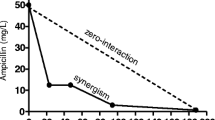Abstract
Methanol extracts fromChlorococcum strain HS-101 andDunaliella primolecta strongly inhibited the growth of a strain of methicillin-resistantStaphylococcus aureus (MRSA), which is causing serious problems in Japanese hospitals. So that the anti-MRSA substance(s) could be purified and identified, the growth medium was improved for antibiotic production. When the two strains were cultured in their improved media, antibiotic production byChlorococcum strain HS-101 was 1.8-fold that in the standard BG-11 medium, and production byD. primolecta was 2.3-fold. The activity pattern of fractions eluted by silica-gel or gel-permeation chromatography suggested that both strains produced two antibiotic substances. Identification of the purified substances by NMR and GC-MS showed that one of the active substances in both strains wasα-linolenic acid. Ten fatty acids from other sources were tested, and it was found that unsaturated fatty acids had antibiotic activity against MRSA, with the highest activity that of γ-linolenic acid.
Similar content being viewed by others
References
Bligh EG, Dyer WJ (1959) A rapid method of total lipid extraction and purification. Can. J. Biochem. Physiol. 37: 911–917.
Bruce DL, Duff DCB, Antia NJ (1967) The identification of two antibacterial products of the marine planktonic algalsochrysis galbana. J. gen. Microbiol. 48: 293–298.
Cannell RJP (1993) Algae as a source of biologically active products. Pestic. Sci. 39: 147–153.
Chang T, Ohta S, Ikegami N, Miyata H, Kashimoto T, Kondo M (1993) Antibiotic substances produced by a marine green alga,Dunaliella primolecta. Biores. Technol. 44: 149–153.
Dehmer GJ, Popma JJ, van den Berg EK, Eighhorn EJ, Prewitt JB, Campbell WB, Jennings L, Willerson JT, Schmitz JM (1988) Reduction in the rate of early restenosis after coronary angioplasty by a diet supplemented with n-3 fatty acids. New Engl. J. Med. 319:733–740.
Higgs MD (1981) Antimicrobial components of the red algaLaurencia hybrida (Rhodophyta, Rhodomelaceae). Tetrahedron 37: 4255–4258.
Ichimura T, Itoh T (1977) Preservation methods of microalgae (I). In Nei T (ed.), Preservation Methods of Microalgae. University of Tokyo Press, Tokyo, 355–373.
Kakisawa H, Asari F, Kusumi T, Toma T, Sakurai T, Oohusa T, Hara Y, Chihara M (1988) An allelopathic fatty acid from the brown algaCladosiphon okamuranus. Phytochemistry 27: 731–735.
Lustigman B (1988) Comparison of antibiotic production from four ecotypes of the marine alga,Dunaliella. Bull. envir. Contam. Toxicol. 40: 18–22.
Mason CP, Edwards KR, Carlson RE, Pignatello J, Gleason FK, Wood JM (1982) Isolation of chlorine-containing antibiotic from the freshwater cyanobacteriumScytonema hofmanni. Science 215:400–402.
Matsueda S, Shinpo K, Abe K, Karasawa H, Katsukura Y (1987) Studies on antitumor active glycoprotein fromChlorella vulgaris. II. Glycoprotein hydrolyzed with hydrolase. Yakugaku Zasshi 107:694–697.
McCracken MD, Middaugh RE, Middaugh RS (1980) A chemical characterization of an alga] inhibitor obtained fromChlamydomonas. Hydrobiologia 70: 271–276.
Ohta S, Chang T, Aozasa O, Kondo M, Miyata H (1992) Sustained production of arachidonic and eicosapentaenoic acids by the red algaPorphyridium purpureum cultured in a light/dark cycle. J. Ferment. Bioengng 74: 398–402.
Ohta S, Chang T, Ikegami N, Kondo M, Miyata H (1993) Antibiotic substance produced by a newly isolated marine microalga,Chlorococcum HS-101. Bull. envir. Contam. Toxicol. 50: 171–178.
Pratt RH, Daniels TC, Eiler JJ, Gunnison JB, Kumler WD, Oneto JF, Strait LA, Spoehr HA, Hardin GJ, Milner HW, Smith JHC, Strain HH (1944) Chlorellin, an antibacterial substance fromChlorella. Science 99: 351–352.
Reichelt JL, Borowitzka MA (1984) Antimicrobial activity from marine algae: results of a large-scale screening programme. Hydrobiologia 116/117 (Dev. Hydrobiol. 22): 158–168.
Rippka R, Deruelles J, Waterbury JB, Herdman M, Stanier RY (1979) Generic assignments, strain histories and properties of pure cultures of cyanobacteria. J. gen. Microbiol. 111: 1–61.
Rossell K-G, Srivastava LM (1987) Fatty acids as antimicrobial substances in brown algae. Hydrobiologia 151/152 (Dev. Hydrobiol. 41): 471–475.
Yamamoto K, Shibahara A, Nakayama T, Kajimoto G (1991) Determination of double-bond positions in highly unsaturated fatty acids by GC-MS. Yukagaku 40: 497–506.
Author information
Authors and Affiliations
Rights and permissions
About this article
Cite this article
Ohta, S., Shiomi, Y., Kawashima, A. et al. Antibiotic effect of linolenic acid fromChlorococcum strain HS-101 andDunaliella primolecta on methicillin-resistantStaphylococcus aureus . J Appl Phycol 7, 121–127 (1995). https://doi.org/10.1007/BF00693057
Received:
Revised:
Accepted:
Issue Date:
DOI: https://doi.org/10.1007/BF00693057




